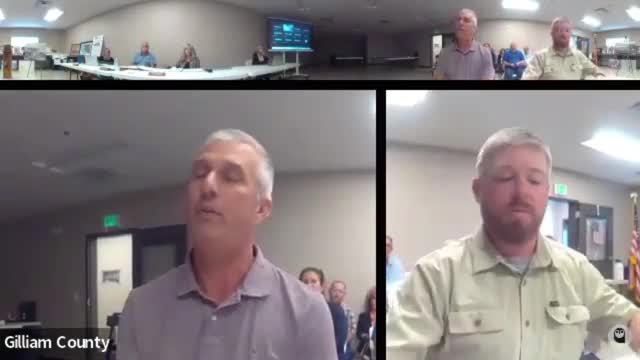Virtual fencing emerges as solution for wildfire recovery
August 24, 2024 | Gilliam County, Oregon
This article was created by AI summarizing key points discussed. AI makes mistakes, so for full details and context, please refer to the video of the full meeting. Please report any errors so we can fix them. Report an error »

In a recent government meeting, officials discussed the aftermath of the Lone Rock fire, which burned approximately 50,000 acres in Gillam County, significantly impacting local ranchers and their livestock operations. The meeting highlighted the urgent need for fencing repairs and innovative solutions to manage grazing in the affected areas.
Initially, the district considered aerial imagery from Pictometry or EagleView to assess the damage, but the cost of $24,000 led them to explore more cost-effective options. They decided to utilize satellite imagery, which is available at half the price, to conduct post-fire inventories and evaluate restoration needs across the upper Rock Creek watershed.
The meeting also addressed the extensive damage to fencing, with an estimated 300 miles of fence destroyed, costing around $9.5 million to replace. Officials emphasized the importance of swift action, as rebuilding efforts could take years. Many ranchers lost nearly all their grazing pastures, complicating recovery efforts.
A key proposal discussed was the implementation of virtual fencing technology, which allows ranchers to manage livestock without physical barriers. This system uses GPS-enabled collars that emit auditory cues and mild shocks to keep cattle within designated areas. The technology could help ranchers utilize available grazing land more effectively, especially in the wake of the fire.
Officials outlined plans to acquire mobile virtual fence stations, which could be deployed as needed, providing a long-term solution for future wildfire incidents. The estimated cost for this initiative is $277,000, a figure deemed reasonable given the scale of the challenges faced.
Additionally, the federal government has approved grazing on Conservation Reserve Program (CRP) lands, offering further support to ranchers affected by the fire. However, the lack of existing fencing remains a significant barrier to utilizing these resources effectively.
The meeting underscored the collaborative efforts between local officials, ranchers, and federal programs to address the immediate and long-term impacts of the Lone Rock fire, aiming to restore the region's agricultural viability.
Initially, the district considered aerial imagery from Pictometry or EagleView to assess the damage, but the cost of $24,000 led them to explore more cost-effective options. They decided to utilize satellite imagery, which is available at half the price, to conduct post-fire inventories and evaluate restoration needs across the upper Rock Creek watershed.
The meeting also addressed the extensive damage to fencing, with an estimated 300 miles of fence destroyed, costing around $9.5 million to replace. Officials emphasized the importance of swift action, as rebuilding efforts could take years. Many ranchers lost nearly all their grazing pastures, complicating recovery efforts.
A key proposal discussed was the implementation of virtual fencing technology, which allows ranchers to manage livestock without physical barriers. This system uses GPS-enabled collars that emit auditory cues and mild shocks to keep cattle within designated areas. The technology could help ranchers utilize available grazing land more effectively, especially in the wake of the fire.
Officials outlined plans to acquire mobile virtual fence stations, which could be deployed as needed, providing a long-term solution for future wildfire incidents. The estimated cost for this initiative is $277,000, a figure deemed reasonable given the scale of the challenges faced.
Additionally, the federal government has approved grazing on Conservation Reserve Program (CRP) lands, offering further support to ranchers affected by the fire. However, the lack of existing fencing remains a significant barrier to utilizing these resources effectively.
The meeting underscored the collaborative efforts between local officials, ranchers, and federal programs to address the immediate and long-term impacts of the Lone Rock fire, aiming to restore the region's agricultural viability.
View full meeting
This article is based on a recent meeting—watch the full video and explore the complete transcript for deeper insights into the discussion.
View full meeting
